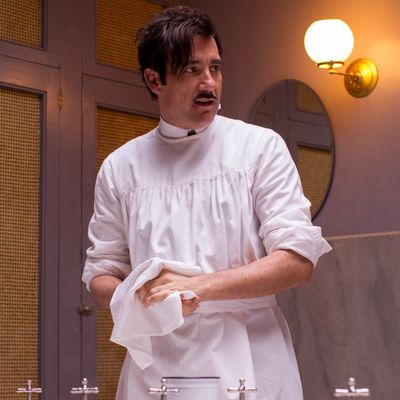
At a time when cults form around top-to-bottom filmmakers like Quentin Tarantino and Christopher Nolan, Steven Soderbergh is in some ways a throwback to the golden age of the Hollywood auteur. He adapts his style to a range of genres and subjects, sometimes in scripts he’s helped develop, and other times in material, like The Knick, written by Jack Amiel and Michael Begler, to which he’s arrived after the fact.
Viewers of the Cinemax series who have kept up with Soderbergh’s breathless output — 14 features in the last decade, plus a supposedly impending retirement that increasingly seems like a put-on — will instantly recognize the director’s signature: The sharp, hyperreal visual style, courtesy of RED cameras, that has been his trademark since 2008’s Che. A driving, percussive Cliff Martinez score. A penchant for crisp, scene-setting title cards. Innovative cross-cutting among parallel story lines, a Soderbergh motif since Traffic (2000).
Compared to some of Soderbergh’s other period pieces, such as 2006’s The Good German, shot with anachronistic lenses, or the wonderful Depression coming-of-age story King of the Hill (1993), The Knick is admirably anti-nostalgic. It focuses on a group of doctors whose quest for progress leaves a large pile of bodies in its wake. It’s not the first time Soderbergh has centered his narrative on a boundary-testing outsider, whether it’s Che Guevara or Erin Brockovich, or the first time his characters’ actions have been read as a metaphor for Soderbergh’s filmmaking process.
Like Soderbergh, Dr. John Thackery (Clive Owen) works within a system but turns it toward his own ends. “We live in a time of endless possibility,” he says at the beginning of the show — a motto that might well apply to the director. Here are some Soderberghian interests that run throughout the series.
Procedure
In Che (2008), Soderbergh inverted the methods of traditional biopic; he said he wanted to film the scenes that would occur “before or after” the typical rousing speeches and eureka moments. Just as the four-hour-plus Che re-enacted grueling jungle campaigns in Cuba and Bolivia, The Knick devotes much of its running time to the specifics of surgery, unafraid of bogging down in medical jargon or details about, say, which kinds of sutures work best and how to vacuum blood.
Camaraderie and Collusion
Hardly the only recent Soderbergh offering to feature an emphasis on male bonding (Magic Mike, Behind the Candelabra), The Knick finds an odd parallel in the Ocean’s trilogy. Progress at the Knickerbocker often seems to involve covert, heistlike operations: Dr. Algernon Edwards (André Holland) runs a clinic for African-American patients out of the hospital’s basement. In the middle of the night, Bertie (Michael Angarano) and Thackery experiment on prostitutes to perfect a procedure for placenta previa.
Financials
Cost-conscious about his filmmaking, Soderbergh naturally doesn’t shy from the economics of any subject he tackles. Magic Mike spent time parsing Channing Tatum’s business schemes and his prospects for upward mobility. Contagion and Haywire, in different ways, hinted at government conspiracies with the private sector. The Knick reminds us that financial perils are nothing new. In the first episode, we learn the Knick is losing nearly $30,000 per year; later installments deal with the expense of acquiring a then-novel X-ray machine.
Statistics
Contagion (2011) dwelled on case histories and talk of R noughts. The Knick shows a similar interest in data and research and maps the spread of a different disease, typhus.
Dehumanization
Dr. Christiansen, who commits suicide after a botched operation, “lost sight of the procedure,” Thackery says. “Once a man shifts his mind from the surgical field to the patient under the drape, it’s only a matter of time.” In The Knick, being a doctor means affecting an almost sociopathic level of professional detachment — seeing human beings as objects (or test subjects). That’s one of the themes of The Girlfriend Experience (2009), which casts Sasha Grey as a high-end prostitute providing ersatz companionship.
Charlatanism
Jude Law promotes sham virus cures in Contagion. Side Effects (2013) hinges on the supposed wonder drug Ablixa. Even the first of Soderbergh’s two Spalding Gray films, Gray’s Anatomy (1996), in which Gray recalls his worldwide journeys to treat an ocular condition known as a macular pucker, includes a lengthy segment on quack medicine. In episode six, Dr. Thackery becomes enraged after getting an offer to put his name on a liniment he knows is useless.
De-Eroticized Nudity
Soderbergh has always had an uneasy relationship with nudity; in the ironically named Sex, Lies, and Videotape (1989) and Full Frontal (2002), there’s no skin shown at all. When Soderbergh does shoot nudity, he tends to show bodies in a disorienting way. Sasha Grey is seen unclothed so early and matter-of-factly in The Girlfriend Experience that it takes the issue off the table. In The Knick, Spring Breakers’ Rachel Korine’s performance as the prostitute Junia is alienating simply by the fact that she’s barely clothed at all.
Loss and Regret
Visually evoking Once Upon a Time in America, The Knick often finds Thackery holed up in an opium den. While Thackery’s addiction to cocaine and morphine is based on that of real-life physician William Halsted (who appears, fictionalized, in episode seven), it’s also not the first time Soderbergh has taken a clear-eyed look at a solitary figure in hallucinatory reverie. His much-maligned 2002 remake of Solaris is another portrait of a man who retreats into his own illusions.




